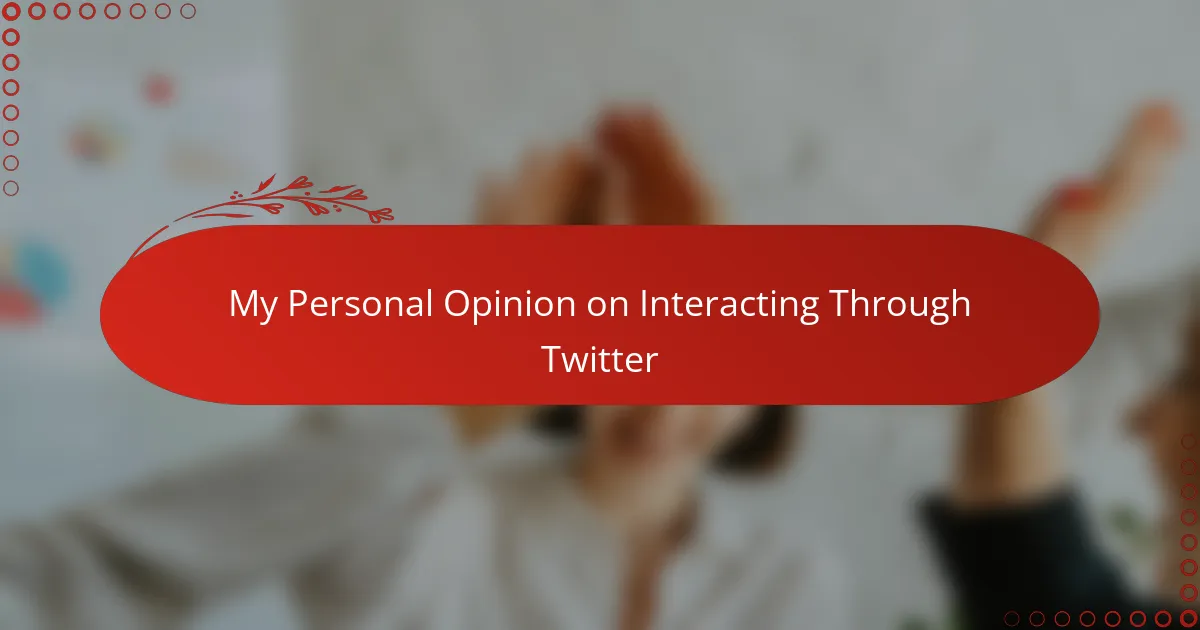Key takeaways
- Twitter enhances radio broadcasting by fostering real-time conversations and audience engagement, creating a sense of community beyond live shows.
- Engagement strategies like posing open-ended questions and recognizing listener contributions strengthen connections and keep interactions lively.
- Challenges include managing rapid tweet interactions, filtering negative comments, and balancing prompt responses with authenticity.
- Effective communication on Twitter relies on being concise, posting at key moments, and prioritizing meaningful listener interactions over sheer volume.
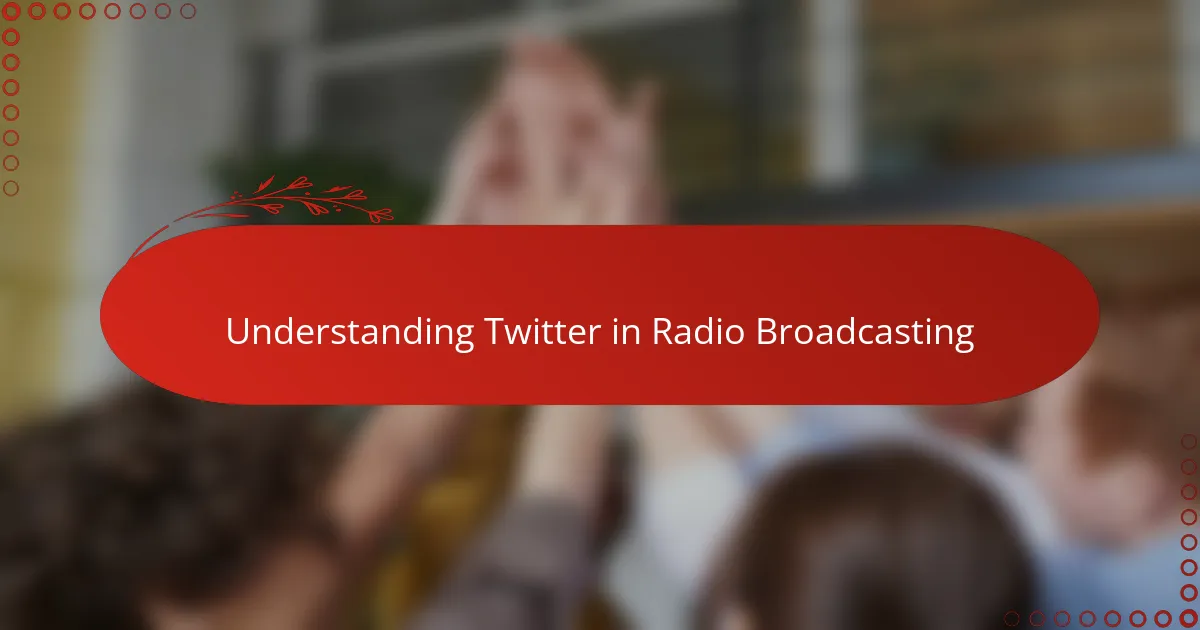
Understanding Twitter in Radio Broadcasting
Twitter has reshaped how we interact with radio audiences. I remember early in my career feeling excited—and a bit overwhelmed—by how fast tweets flew by during live shows. It made me realize that radio isn’t just about broadcasting anymore; it’s about real-time conversations.
What struck me most is how Twitter breaks down barriers, letting listeners from anywhere chime in instantly. Have you ever wondered how a simple tweet can spark a full-blown discussion on-air? For me, that immediacy adds a fresh, energetic pulse to traditional radio.
Understanding Twitter means recognizing its power as a tool for engagement and feedback. It’s not just about pushing content; it’s about listening, responding, and building a community. From my experience, embracing this dynamic interaction elevates radio broadcasting to a whole new level.
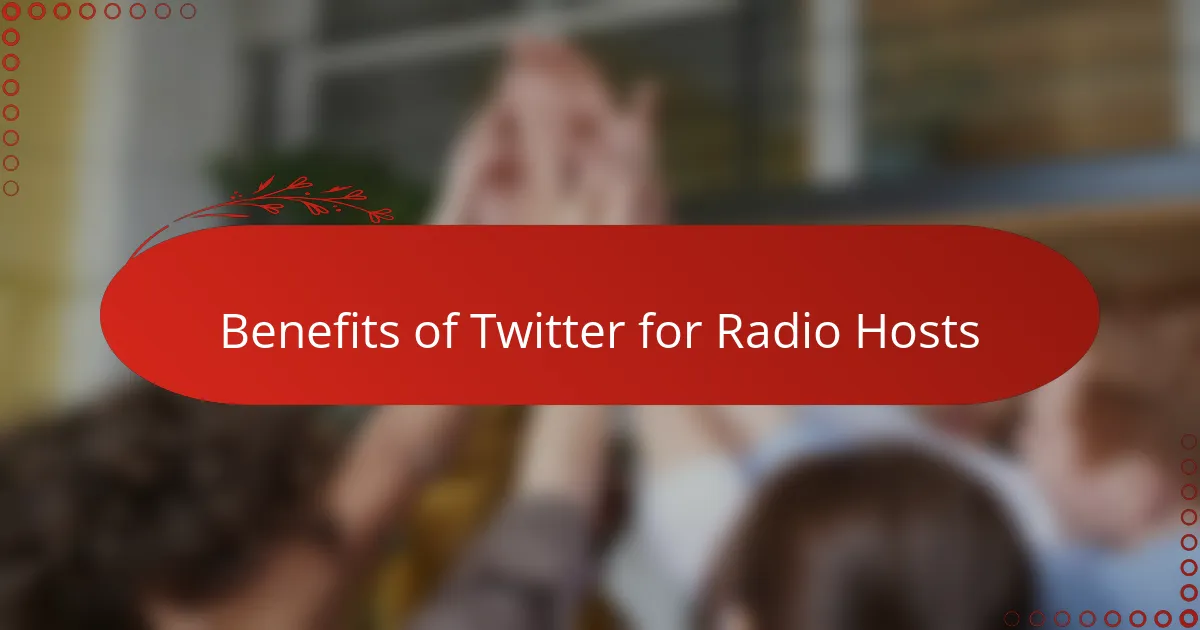
Benefits of Twitter for Radio Hosts
One of the biggest benefits I’ve found is how Twitter lets radio hosts connect directly with their audience in ways that weren’t possible before. I remember a night when listeners started tweeting song requests during my live show — the instant feedback made the broadcast feel more like a conversation than a one-way street. Doesn’t it feel rewarding to know your listeners aren’t just hearing you, but actually taking part?
Another advantage is the chance to build a loyal community beyond your broadcast time. I’ve seen listeners engage throughout the day, sharing opinions or reacting to topics we covered on air. This ongoing interaction keeps the connection alive, making the radio show feel like part of people’s daily lives rather than just a momentary experience.
Lastly, Twitter offers a unique way to gather insights and tune content to what actually matters to listeners. When I scan through replies or monitor trending hashtags, it’s like having a real-time pulse on my audience’s interests and moods. Have you noticed how exciting it is when you adjust your show based on those live insights? It truly makes broadcasting feel more relevant and responsive.
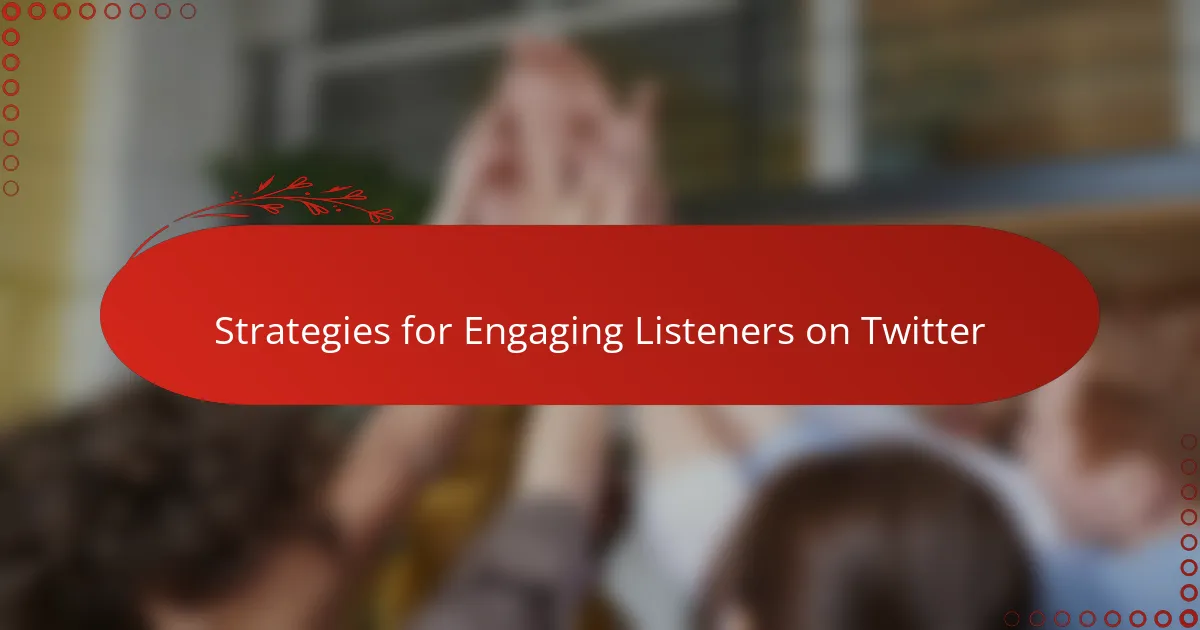
Strategies for Engaging Listeners on Twitter
One strategy I rely on to engage listeners on Twitter is asking open-ended questions during the show. I’ve found that posing something simple yet thought-provoking sparks a flood of replies that bring the conversation alive. Have you ever noticed how a well-timed question can turn passive listeners into active participants? That instant exchange creates a sense of belonging and keeps the energy buzzing both on air and online.
Another approach I swear by is retweeting and spotlighting listener comments or fan art. When I share their tweets on the station’s feed or mention them live, it shows I genuinely value what they contribute. It feels like building friendships over time—something deeper than just broadcasting from behind a mic. From my experience, this recognition motivates listeners to stay engaged and invite their networks into the conversation too.
Timing also plays a big role. I try to tweet during key moments—like song changes, breaking news, or funny bloopers—when listeners are most attentive. That way, tweets feel timely, relevant, and naturally weave into the broadcast experience. Isn’t it amazing how a well-planned post can amplify the live show’s impact and make followers feel they’re part of something special? This rhythm between on-air content and social interaction is something I keep refining to keep the connection strong.
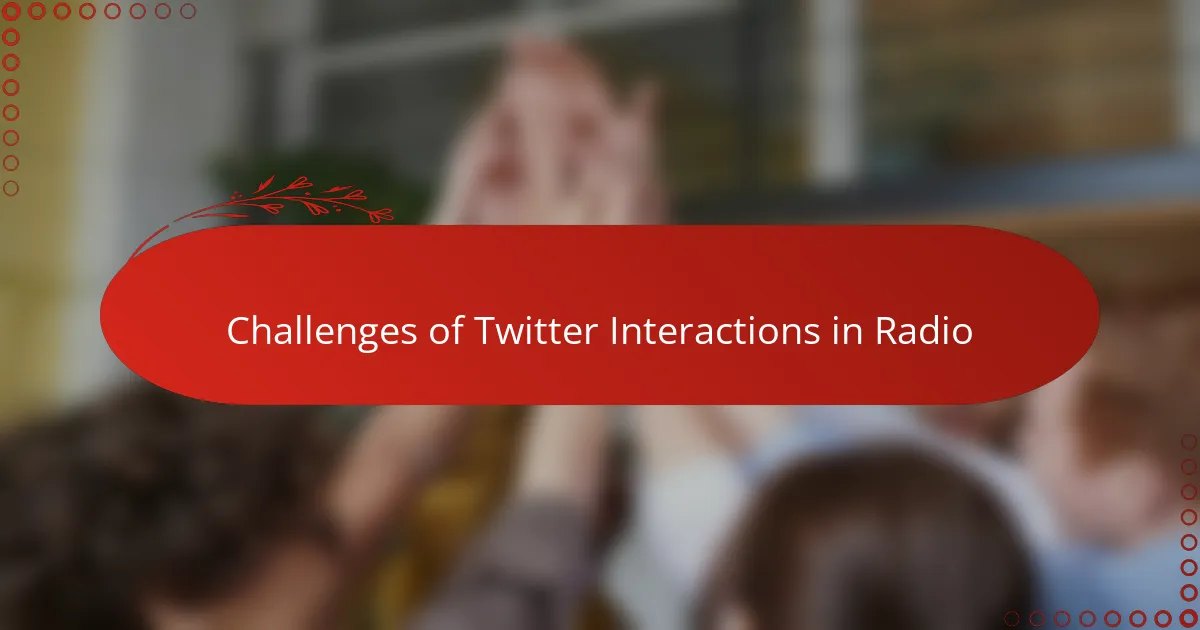
Challenges of Twitter Interactions in Radio
Navigating Twitter during a live radio show can feel like juggling flaming torches. I’ve lost track of how many times a sudden surge of tweets overwhelmed me, making it tough to respond thoughtfully without missing the flow on air. Have you ever tried keeping up with a rapid-fire chat while also hosting? It’s a real challenge to stay present in both worlds at once.
Another tricky part is managing the tone and content of tweets. Not every comment is constructive—sometimes the feed can turn harsh or off-topic, which can throw the whole vibe off. I’ve learned that filtering through this noise takes patience and a thick skin, especially when you want to keep the interaction positive and welcoming.
Lastly, there’s the pressure of immediacy. Twitter demands quick reactions, but not every moment calls for an instant reply. I’ve often wrestled with whether to engage right away or wait, fearing that a delayed response might lose listeners’ attention. Balancing timing and authenticity is a delicate dance that every radio host on Twitter soon understands.
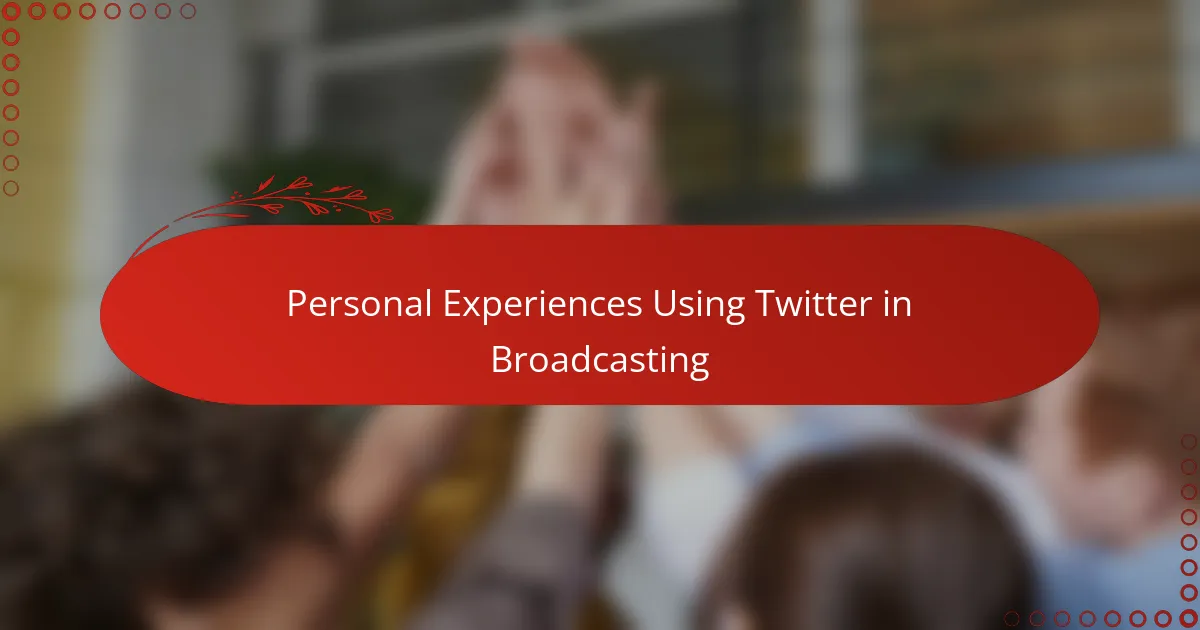
Personal Experiences Using Twitter in Broadcasting
Interacting through Twitter while broadcasting has often felt like having a lively co-host right beside me. I recall one evening when a listener’s witty tweet about a guest’s comment sparked a flurry of responses, turning a routine segment into an unexpected highlight. Doesn’t it feel incredible when a simple tweet energizes the entire show like that?
Sometimes, Twitter surprises me with its immediacy—listeners posting reactions seconds after a story breaks, giving me a real-time sense of what resonates. I’ve noticed that tuning into these live reactions not only shapes how I steer conversations but also deepens my connection with the audience. Have you ever felt that instant feedback moment where you know you truly have their attention?
At the same time, juggling on-air duties while engaging over Twitter can be a whirlwind. I remember one frantic broadcast when the tweet stream exploded, and I struggled to respond thoughtfully without losing my train of thought. That chaotic energy taught me to develop quick instincts and prioritize which interactions deserve attention right away—a skill every broadcaster must hone to thrive in this fast-paced space.
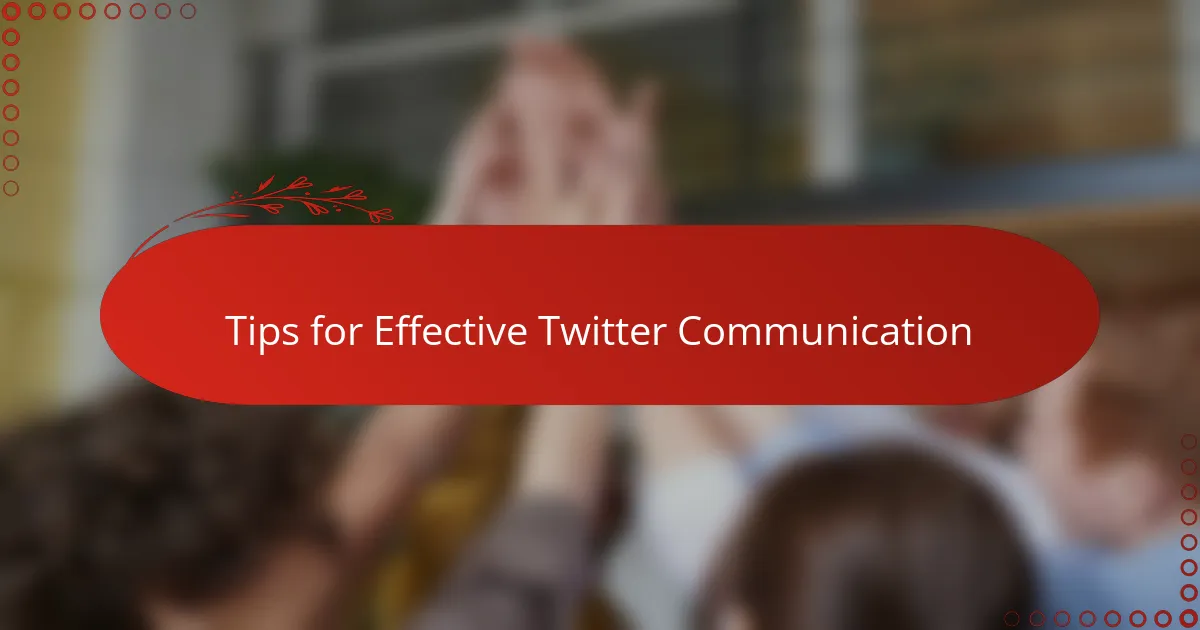
Tips for Effective Twitter Communication
One tip I always keep in mind is to be concise but authentic. Twitter’s fast pace means you’ve got seconds to grab attention, so crafting tweets that feel genuine but clear is key. Have you ever noticed how a well-chosen phrase or a bit of personality can make a more lasting impression than a long message? From my experience, that balance is what keeps listeners coming back for more.
Another thing I’ve learned is the power of timing. Posting tweets during peak show moments—like a funny comment or a big announcement—can really boost engagement. I remember one show where a quick, playful tweet right after a hilarious blooper earned a flood of retweets and replies, turning a small moment into a shared experience. Isn’t it fascinating how syncing social activity with live content multiplies the connection?
Lastly, don’t underestimate the value of listening. Twitter isn’t just about broadcasting your thoughts; it’s about tuning in to what your audience says and responding thoughtfully. Early on, I struggled with this balance because I wanted to respond to every tweet immediately, which just wasn’t sustainable. Now, I prioritize meaningful interactions, which feels more rewarding for both me and my listeners. Have you tried focusing less on quantity and more on quality in your Twitter conversations? It’s a game changer.
